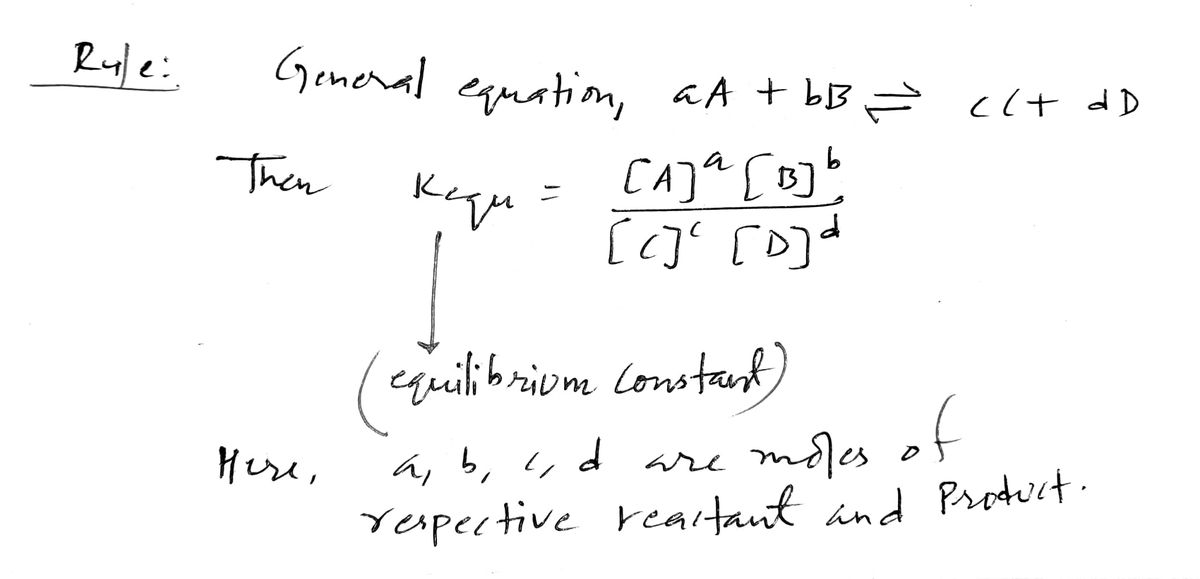4) To determine the equilibrium just combine the initial and the change. H2(g) + IM -X IM-X Initial (1) Change (C) Equilibrium (E) K = [H,O][CO] _ [x][x] [H₂][CO₂] [IM-x][IM-x] Initial 5) Now we can write the equilibrium expression and plug in our equilibrium values from the table and solve for x algebraically. Answer CO2(g) IM -X IM-X Initial (I) Change (C) Equilibrium (E) Further examples Write a table and equilibrium expression with equilibrium concentrations for the following equilibrium equations. HO2(g) + NO2(g) → HO₂NO2(g) [HO2] [NO2] =IM HO2(g) + [HO₂NO₂] = 0 H₂O(g) + CO(g) 0 0 +x +x NO2(g) X => X HO₂NO2(g)
4) To determine the equilibrium just combine the initial and the change. H2(g) + IM -X IM-X Initial (1) Change (C) Equilibrium (E) K = [H,O][CO] _ [x][x] [H₂][CO₂] [IM-x][IM-x] Initial 5) Now we can write the equilibrium expression and plug in our equilibrium values from the table and solve for x algebraically. Answer CO2(g) IM -X IM-X Initial (I) Change (C) Equilibrium (E) Further examples Write a table and equilibrium expression with equilibrium concentrations for the following equilibrium equations. HO2(g) + NO2(g) → HO₂NO2(g) [HO2] [NO2] =IM HO2(g) + [HO₂NO₂] = 0 H₂O(g) + CO(g) 0 0 +x +x NO2(g) X => X HO₂NO2(g)
Chemistry
10th Edition
ISBN:9781305957404
Author:Steven S. Zumdahl, Susan A. Zumdahl, Donald J. DeCoste
Publisher:Steven S. Zumdahl, Susan A. Zumdahl, Donald J. DeCoste
Chapter1: Chemical Foundations
Section: Chapter Questions
Problem 1RQ: Define and explain the differences between the following terms. a. law and theory b. theory and...
Related questions
Question
100%
Part 4 and further example please
![4) To determine the equilibrium just combine the initial and the change.
H2(g) +
IM
Initial (1)
Change (C)
Equilibrium (E)
K =
[H,O][CO]
[x][x]
[H₂][CO₂] [IM-x][IM-x]
-X
1M- x
Initial
Answer
5) Now we can write the equilibrium expression and plug in our equilibrium values from the
table and solve for x algebraically.
CO2(g)
IM
Initial (I)
Change (C)
Equilibrium (E)
-X
IM-X
Further examples
Write a table and equilibrium expression with equilibrium concentrations for the following
equilibrium equations.
HO2(g) + NO2(g) → HO₂NO2(g)
[HO₂] [NO2] = 1M
HO2(g) +
H₂O(g) + CO(g)
0
0
+x
+x
[HO₂NO₂] = 0
X
NO2(g)
X
HO₂NO2(g)](/v2/_next/image?url=https%3A%2F%2Fcontent.bartleby.com%2Fqna-images%2Fquestion%2F3f4c86b2-1247-4388-bf18-f90827f5643c%2Fdd7e4891-7f83-45ce-8632-7119d669ce92%2F599u2u_processed.jpeg&w=3840&q=75)
Transcribed Image Text:4) To determine the equilibrium just combine the initial and the change.
H2(g) +
IM
Initial (1)
Change (C)
Equilibrium (E)
K =
[H,O][CO]
[x][x]
[H₂][CO₂] [IM-x][IM-x]
-X
1M- x
Initial
Answer
5) Now we can write the equilibrium expression and plug in our equilibrium values from the
table and solve for x algebraically.
CO2(g)
IM
Initial (I)
Change (C)
Equilibrium (E)
-X
IM-X
Further examples
Write a table and equilibrium expression with equilibrium concentrations for the following
equilibrium equations.
HO2(g) + NO2(g) → HO₂NO2(g)
[HO₂] [NO2] = 1M
HO2(g) +
H₂O(g) + CO(g)
0
0
+x
+x
[HO₂NO₂] = 0
X
NO2(g)
X
HO₂NO2(g)
Expert Solution
Step 1

Step by step
Solved in 3 steps with 3 images

Knowledge Booster
Learn more about
Need a deep-dive on the concept behind this application? Look no further. Learn more about this topic, chemistry and related others by exploring similar questions and additional content below.Recommended textbooks for you

Chemistry
Chemistry
ISBN:
9781305957404
Author:
Steven S. Zumdahl, Susan A. Zumdahl, Donald J. DeCoste
Publisher:
Cengage Learning

Chemistry
Chemistry
ISBN:
9781259911156
Author:
Raymond Chang Dr., Jason Overby Professor
Publisher:
McGraw-Hill Education

Principles of Instrumental Analysis
Chemistry
ISBN:
9781305577213
Author:
Douglas A. Skoog, F. James Holler, Stanley R. Crouch
Publisher:
Cengage Learning

Chemistry
Chemistry
ISBN:
9781305957404
Author:
Steven S. Zumdahl, Susan A. Zumdahl, Donald J. DeCoste
Publisher:
Cengage Learning

Chemistry
Chemistry
ISBN:
9781259911156
Author:
Raymond Chang Dr., Jason Overby Professor
Publisher:
McGraw-Hill Education

Principles of Instrumental Analysis
Chemistry
ISBN:
9781305577213
Author:
Douglas A. Skoog, F. James Holler, Stanley R. Crouch
Publisher:
Cengage Learning

Organic Chemistry
Chemistry
ISBN:
9780078021558
Author:
Janice Gorzynski Smith Dr.
Publisher:
McGraw-Hill Education

Chemistry: Principles and Reactions
Chemistry
ISBN:
9781305079373
Author:
William L. Masterton, Cecile N. Hurley
Publisher:
Cengage Learning

Elementary Principles of Chemical Processes, Bind…
Chemistry
ISBN:
9781118431221
Author:
Richard M. Felder, Ronald W. Rousseau, Lisa G. Bullard
Publisher:
WILEY